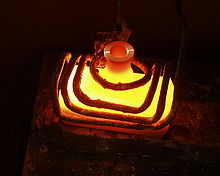Inductive heating
Inductive heating is a method of heating electrically conductive bodies by means of eddy current losses generated in them .
The devices used for this are the induction heater and the induction furnace . By means of a low-frequency (here around 50–300 Hz), medium-frequency (200 Hz-10 kHz after; 1 kHz-100 kHz after) or high-frequency alternating current flowing coil (the inductor ), they generate an alternating magnetic field that induces eddy currents in the material .
In ferromagnetic materials, magnetic reversal losses also occur below the Curie temperature .
Common uses of inductive heating are tempering , annealing , soldering , welding , melting , shrink fitting and material testing.
features
The heat is generated directly in the body itself, so it does not have to be transferred by conduction . The heat output is easy to control. The electrical power comes from special frequency converters (see inverters or resonance converters ) or directly from the mains.
Inductive heating can take place through non-conductive materials, the environment is only heated indirectly. The process can be used under any gases or in a vacuum; there is no contamination from an external heat source.
The emitted interference is disadvantageous, particularly in the case of high-frequency systems: other electrical or electronic systems or devices in the immediate vicinity can be disturbed.
The shape of the mostly water-cooled inductor is manufactured according to the shape and size of the workpiece or the heating zone. The frequency often has to be adapted to the size and conductivity of the workpiece: due to the skin depth, high frequencies lead to heating close to the surface.
The concentration of the field lines through pole shoes is possible and is used for point-like heating or the design / shaping of the heating zone.
The efficiency depends on the distance and the conductivity of the work coil and the workpiece. It increases the worse the conductivity of the workpiece. With poorly conductive materials such as iron, cooling of the inductor can often be dispensed with (e.g. with the induction hotplate ).
The acquisition costs of an induction system can be significantly higher than when using conventional methods such as resistance heating or heating with a flame. Due to the high efficiency of today's semiconductor generators and the significantly higher energy density and the generation of heat directly in the workpiece, inductive heating is highly efficient and often more economical than indirect heating methods.
Applications
- Induction hob
- targeted heating of certain areas, e.g. B. for hardening and hot forming or for coatings, adhesive or soldered connections
- Heating of the external partners for the production or separation of shrink connections
- Zone melting process
- Crucible-free melting
- Heating of the getter in the case of vacuum tubes, heating of vacuum built-in parts or electrodes through the glass bulb
- Dieless drawing , a tool-free wire drawing
- Active thermography
See also
literature
- Bernard Nacke, Herbert Pfeifer (eds.), Olaf Irretier, Taschenbuch industrial heat technology , 2007, ISBN 3-8027-2937-4
- Günter Benkowsky, induction heating: hardening, annealing, melting, soldering, welding; Basics and practical instructions… , 1990, ISBN 3-341-00813-6
- Elmar Wrona, Numerical simulation of the heating process for the inductive surface hardening of complex geometries , 2005, ISBN 3-86537-396-8
- Valery Rudnev, Don Loveless, Raymond Cook, Micah Black, Handbook of Induction Heating , 2003, ISBN 0-8247-0848-2
Web links
- Institute for Electrical Process Engineering, Leibniz University Hannover
- Power calculations for inductive heating
- What is induction heating?
Individual evidence
- ↑ http://universal_lexikon.deacademic.com/273878/Mittelfrequenz
- ↑ http://www.induktionserwaermung.de/html/induktionserwaermung.html
- ↑ Kurt Kegel: The practice of inductive heat treatment . Springer-Verlag, 2013, p. 55 ( limited preview in Google Book search).

